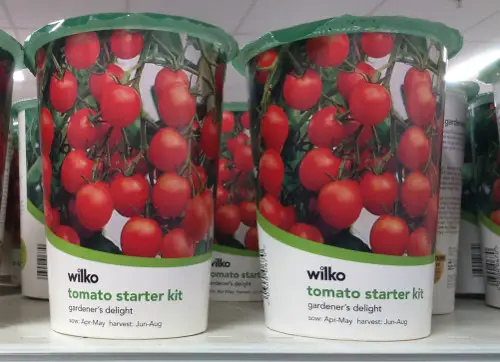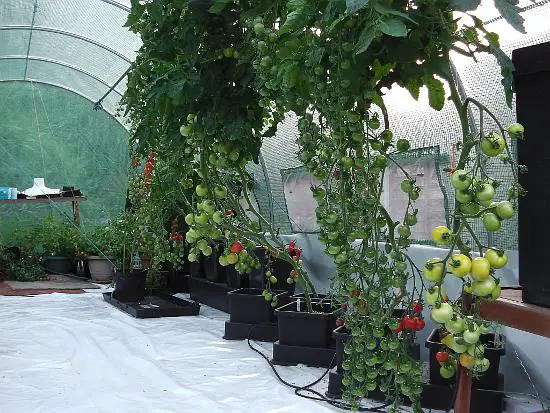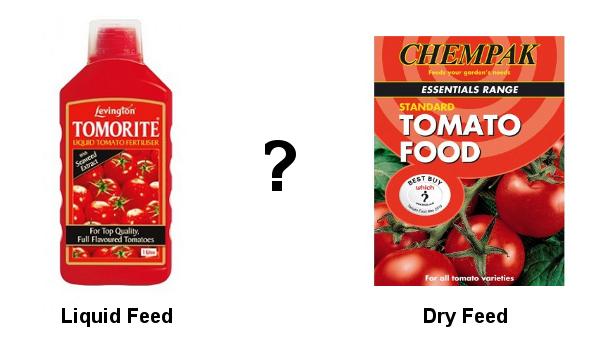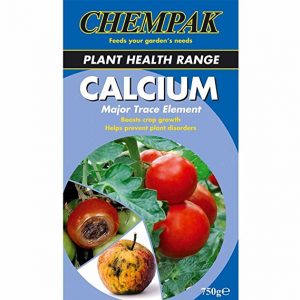In this Newsletter: A brief getting started tomato growing guide, keeping it simple, choice of varieties, best containers for tall and bush varieties, growing tomatoes in hot climates, growing tomatoes in a greenhouse, feeding suggestions for self watering planters.
Keeping it simple
We are approaching the time when sowing seed is no longer an option – tomatoes won’t mature before the end of the season in the UK. However, buying tomato plants online or from the garden centre is an option, especially if things haven’t gone according to plan and you need to start again.
Greater choice of varieties
There was a time when the only plug plants we could buy were either Moneymaker or Gardener’s Delight. Now we have a huge choice of varieties available as plugs or potted tomato plants.
A brief getting started tomato growing guide…

If you are new to growing tomatoes grow at least one popular cherry variety such as:
- Gardener’s Delight (tall)
- Sungold (tall)
- Tumbling Tom (trailing bush)
These varieties (above) will grow well outside but if you really want to avoid blight, a big problem in a wet summer, try the ones below … available as small plants online:
- Crimson Crush (tall medium/large)
- Lizzano (bush cherry)
- Terenzo (bush cherry)
They are blight resistant hybrids that will produce very good results – more here.
Best containers for tall and bush tomatoes
- Tall varieties in grow bags – three per bag.
- Bush varieties – high sided large pots.
Two or three trailing plants (maximum) in a hanging basket.
Transplant into 4 inch pots before final position, then plant outside in final position end of May – after last frost in UK.
Don’t feed for four or five weeks and try not to over water when first planted.
For bush cherry tomatoes, feed after first flowers set. No need to remove side shoots or pinch out growing tip.
For tall medium/large tomatoes, feed balanced food after first flowers have set – tomato food after second or third truss sets. Remove side shoots from tall varieties and stop plants by pinching out growing tip after four to six trusses.
Bush varieties can be fed as soon as the first flowers begin to set.
That’s it in a nutshell!
Where to start if growing tomatoes in warmer climates such as Africa and India.
I regularly receive emails from people who live in warmer and longer season areas than the UK, wanting to know how to grow tomatoes.
The first thing to understand is that many tomato varieties that perform well in the UK, will possibly be unable to cope in a warmer climate.
You can always find out the best varieties to grow in your area by:
- Visiting your local market and ask where the tomatoes are grown and the name of the varieties.
- Visit your local garden center and discover which varieties they are selling.
- Look in a seed catalogue relevant to your part of the world.
- Email the horticulture department of your capital city’s university, for example – Nairobi, Delhi, Islamabad etc. and ask for information on tomato growing and varieties for your area. You may be able to request an information sheet with details of local growing suggestions and common tomato diseases/problems in your area too.
Growing the right varieties for your climate is the first step to success!
Growing tomatoes in a greenhouse
If you are growing under cover in a greenhouse or pollytunnel, you might think that every variety would excel. Surprisingly, some varieties do better outside than in!
I have found that many of the trailing cherry varieties perform better and taste better when grown outside.
However, the advantages of a greenhouse are that you can start your season earlier and finish later – it extends the season.

Larger varieties usually do better in a greenhouse with more consistent and higher temperatures.
Keeping the rain off of leaves is a real benefit that reduces the threat of blight significantly.
The main issues with a greenhouse are to keep humidity and temperatures from becoming too high.
High humidity may cause fungal problems and reduce the amount of moisture plants are able to release from their leaves, see transpiration.
High temperatures on a hot day can cause heat stress and even check the growth of tomato plants if temperatures reach over 30C see respiration.
Feeding suggestions for self watering planters
Last week I mentioned some of the benefits of self watering planters. Here is a few thoughts on how we might feed our toms when using them.
After the nutrients in the soil have been used up, around four weeks, we have a choice of continuing to feed by way of the soil, or adding water with feed to the reservoir.
When we purchase a Quadgrow Planter for example, we get two containers of dry food, to which we add water. This gives us an “A” and a “B” – known as a two part feed. “A” contains a range of nutrients and “B” contains calcium, By keeping calcium separate, we don’t have an issue with precipitation where the calcium drops out of the solution and doesn’t mix.**
If you have just bought a Quadgrow then go ahead and use the feed provided as per instructions.
If you have a Quadgrow without feed or are using another SWP such as an Oasesbox, then this is a good option.
- Add general or tomato feed to the reservoir.
- Add calcium to the soil.
- Encourage friendly bacteria in the soil by adding liquid seaweed or other organic boost/feed to the soil.
It is best not to add organic feed to a reservoir because microbes need plenty of oxygen which they can obtain better from the soil than from a reservoir.
Having said that, providing extra oxygen to the reservoir, by means of a fish tank air stone and pump, increases the yield of tomatoes significantly! It is highly recommended by the makers of the Autopot System.
The extra oxygen available to roots that grow down into the reservoir, increase the rate of respiration which will give a boost to plant growth.
I would avoid adding calcium to the reservoir but an option is to spray leaves weekly with a foliar feed when tomatoes are swelling to avoid Blossom End Rot which is caused by a calcium deficiency.
Does your general or tomato feed contain calcium?
Take a look at the label…
- If it is a dry feed it probably does
- If it is a liquid feed it probably doesn’t – because of the issue of mixing with other nutrients, mentioned above.**
So where can we get our calcium from?
Chempak Calcium also contains nitrogen so it makes a very good boost for larger varieties applied just after the first truss has begun to set.

Rhys’s “Urban No Dig” Blog
Rhys, a regular Newsletter member and an experienced tomato grower has just put up three articles on how he planted tomatoes, potatoes and alliums. Definitely worth a read!
The website is www.urban-no-dig.com
That’s it for this week – can’t wait to get the plants outside for good!
Regards,
Nick


Leave a Reply